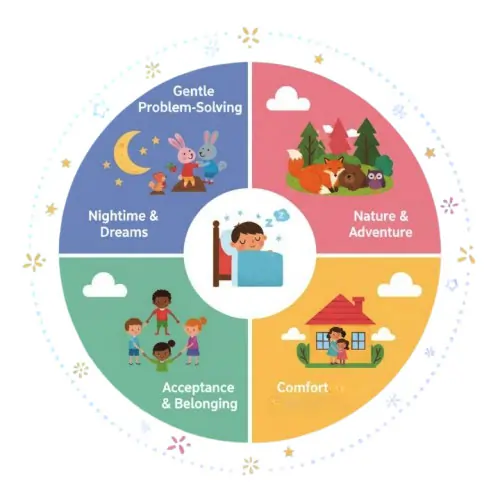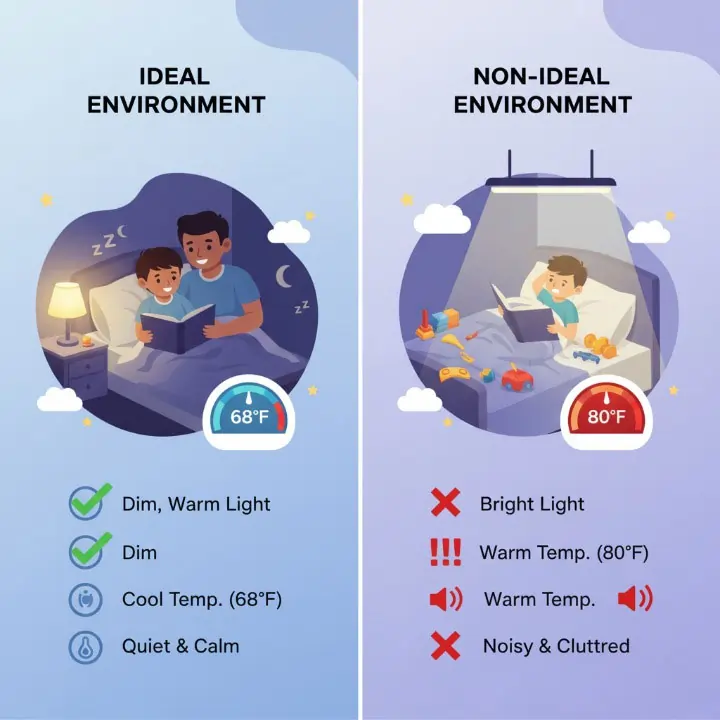How to Make the Perfect Bedtime Story Routine: Calming Stories for Good Sleep
1. Why Bedtime Stories Are Important
For generations, parents have read stories to their kids before bed. These times help you move from a busy day to a restful night of sleep. Reading before bed is more important than ever now that there are devices everywhere.
Bedtime stories help kids get ready for bed and enhance the link between parents and kids. The routine tells the brain that it’s time to sleep, which helps you sleep better. These readings help kids learn new words, understand what they read, and love books.
2. How Reading Before Bed Is Good for Your Mental Health
Reading before bed is good for kids in many ways than just getting them ready for sleep.

The Mental Benefits of Reading Stories Before Bed
| Benefit | Age Group | How It Works |
| Emotional security | 0-5 years | Caregiver presence with familiar stories creates safety |
| Language development | 1-6 years | Exposure to vocabulary and narrative structure |
| Imagination stimulation | 2-8 years | Mental imagery builds creative thinking |
| Stress reduction | 3-10 years | Soothing voice distracts from worries |
| Memory formation | 4-10 years | Repetition strengthens recall abilities |
| Bonding and attachment | All ages | Focused attention deepens relationships |
Stories give kids a secure place to deal with their anxieties and feelings. A caregiver’s voice calms the nervous system, which slows down respiration and pulse rate. Reading to kids before bed every night helps their brains make serotonin and melatonin, which help them sleep. It also builds the brain pathways that help them learn and speak.
3. What Is a Good Bedtime Story?
Some stories aren’t good to read before bed. Bedtime stories that work well have relaxing properties.
The best bedtime stories have a gradual, steady cadence. There are no sudden surprises in the sentences, which run at a slow pace. For preschoolers, try to spend 10 to 15 minutes, and for elementary school kids, try to spend 15 to 20 minutes. Stories should have smooth arcs where characters we know acquire peace or insight.
Looking at the Different Parts of a Story
| Element | Ideal for Bedtime | Not Ideal |
| Pacing | Slow, gentle, predictable | Fast, action-packed |
| Conflict | Minimal, easily resolved | High-stakes, cliffhangers |
| Themes | Comfort, friendship | Fear, danger |
| Length | 10-20 minutes | Over 30 minutes |
| Tone | Calm, reassuring | Intense, dramatic |
| Endings | Satisfying resolution | Open-ended |
4. The Best Bedtime Story Ideas to Help You Sleep
Some themes naturally help you relax.
Nature and Gentle Adventure — Stories set in quiet places like meadows and woodlands are good for the nervous system. Stories about animals finding warm homes provide very calming images.
Home and Comfort — Stories about going home or getting together with relatives meet requirements for safety.
Acceptance and Belonging — Stories that celebrate differences let kids feel good about themselves.
Sleep and Nighttime Themes — Stories that make darkness and dreams seem regular help people feel like they need to sleep.
Gentle Problem-Solving — Kindness helps people work out their differences without getting stressed.

5. Tips for Parents on How to Read Well
The way you tell a tale is just as important as the narrative itself.
Making the Right Environment
- Lighting: Use soft, warm light
- Temperature: Keep the room between 65 and 68 degrees Fahrenheit.
- Sound: Keep the place quiet.
- Comfort: Make sure the youngster is comfortable.
- Positioning: Sit close but not too tight.

Voice Techniques
Your voice helps you relax:
- Talk 25–30% slower than usual.
- Use a voice that is a little deeper and softer.
- Use natural pauses to make a delicate rhythm.
- Keep the loudness steady
- Make it feel warm and cozy
Consistency is Important
- Read at the same time every night
- Use the same place to read
- Keep sessions to 15–20 minutes
- Make reading the last thing you do before bed
6. Suggested Bedtime Stories and Other Resources
Classic Stories for Bedtime
- Goodnight Moon by Margaret Wise Brown
- The Very Hungry Caterpillar by Eric Carle
- Where the Wild Things Are by Maurice Sendak
- Winnie-the-Pooh by A.A. Milne
Modern Favorites
- Guess How Much I Love You by Sam McBratney
- Time for Bed by Mem Fox
- The Going to Bed Book by Sandra Boynton
Online Resources
- Audible and Spotify: Professional narrations
- YouTube: Free bedtime story readings
- Library Apps: Libby and Hoopla for free borrowing
- Podcasts: Sleepy, Circle Round
7. Finish Your Bedtime Routine with Stories
Stories are greatest when they are part of a full evening routine.
Activities Before Reading (30–45 Minutes Before)
- Bath time with warm water
- Putting on pajamas
- Playing or painting quietly
- Slowly dimming the lights
- Cleaning up toys
During-Story
- Herbal tea or warm milk
- Stretching slowly
- Massaging the back or hands
- Holding comfort items
After-Story Wind-Down
- Quietly think about dreams
- A phrase that keeps coming up, like “Time for dreams now”
- A last hug
- Lights out
Bedtime Routines That Are Common
| Routine | Activities | Duration |
| Classic | Bath → Pajamas → Story → Sleep | 45-60 min |
| Quick | Pajamas → Story → Cuddle → Sleep | 20-30 min |
| Mindful | Stretching → Breathing → Story → Sleep | 40-50 min |
8. How to Write Your Own Bedtime Stories
Making up stories just for you makes nighttime more magical.
How to Structure a Story:
- “Once upon a time, in a cozy [place]…” is a familiar opening.
- Soft Start: Tell us about the character’s safe place
- “Tiny Adventure”: A quest or discovery with little stakes
- “Moments of Wonder”: Use words that appeal to the senses
- “Resolution”: The character finds peace and safety
- “And so began the sweetest dreams…”

Story Ideas
- Include your child’s favorite colors, animals, and hobbies in the design.
- Turn everyday events into fun adventures
- Get ideas from nature that change with the seasons
- Talk about how you feel right now or what worries you
- Write stories about places you love
9. Frequently Asked Questions About Telling Stories at Bedtime
Q: When should we start telling bedtime stories?
Start with babies. Babies even benefit from hearing your voice and getting used to things.
Q: How long should stories be?
Try to get 15 to 20 minutes. Adjust for individual children.
Q: What if my child won’t sit still?
This is normal. Let them move around; a lot of kids listen while they play quietly.
Q: Are audiobooks okay to use?
Audiobooks offer value but lack personal connection. Prioritize reading aloud most nights.
Q: What about screens?
Avoid screens 30-60 minutes before bed since blue light disrupts sleep.
Q: How do we handle resistance?
Make reading so appealing they want to participate. Choose books together and let them help.
Q: Do bedtime stories help older children?
Absolutely. Try chapter books with age-appropriate content.
10. Conclusion: Cultivating a Lifelong Love of Reading
Bedtime stories plant seeds that flourish throughout life. Nightly reading improves sleep and emotional regulation while demonstrating the importance of books and showing that intellectual nourishment deserves daily priority.
Every story shared becomes a treasured memory. Children remember the storylines, but more importantly, they recollect being held, hearing your voice, and feeling loved enough that someone stopped everything to read to them.
Start Tonight:
- Select a reassuring narrative
- Set a regular time
- Prepare the space with dim lights
- Speak slowly and lovingly
- Add reassuring rituals
- Maintain consistency
- Observe and adjust
Starting a nightly reading regimen isn’t about perfection. It’s about connection, consistency, and care. Some nights will feel hectic, but the message remains: you are loved, you are protected, and I will be here.
Reading great books or making up your own stories is good for your sleep, your literacy, your emotional growth, and your relationship with your partner. In a world that wants more, quicker, and louder, bedtime stories provide us something special: patience, connection, and the magic of stories that never goes away.
Sweet dreams are coming. Tonight, read a book.


